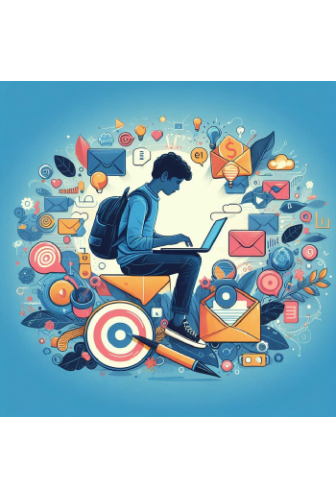Learn Digital Marketing
Digital Marketing Course in Bareilly
Advertisement
Understanding Graphic Design
What is Graphic Design?
Graphic design is the art and practice of visual communication through the use of typography, imagery, color, and layout. It involves creating visual content to convey messages and ideas to a target audience. Graphic design is used in various media, including print, digital, and multimedia, to enhance the visual appeal and effectiveness of communications.
Key Elements of Graphic Design
- Typography: The art of arranging type to make written language legible, readable, and visually appealing. Typography involves font choice, size, spacing, and alignment.
- Color: The use of color in design to evoke emotions, create contrast, and enhance visual interest. Color theory involves understanding how colors interact and their impact on the viewer.
- Imagery: The use of photographs, illustrations, and graphics to support and enhance the message. Imagery helps to create a visual narrative and capture attention.
- Layout: The arrangement of visual elements on a page or screen. Effective layout ensures that content is organized, easy to navigate, and visually engaging.
- Composition: The strategic placement of elements within a design to create a cohesive and aesthetically pleasing whole. Composition involves balance, alignment, and visual hierarchy.
- White Space: Also known as negative space, white space refers to the empty areas around and between elements. It helps to improve readability and focus attention on key content.
Types of Graphic Design
- Print Design: Involves creating designs for printed materials such as brochures, posters, business cards, and packaging. Print design focuses on visual appeal and practical considerations for physical media.
- Web Design: The creation of visual elements for websites and online platforms. Web design includes layout, navigation, and interactive elements to enhance user experience.
- Branding: The development of visual identity for a company or product, including logos, color schemes, and brand guidelines. Branding aims to establish a recognizable and consistent image.
- Advertising Design: The creation of visual content for advertisements across various media, including print, digital, and broadcast. Advertising design focuses on capturing attention and promoting products or services.
- Motion Graphics: The design of animated graphics and visual effects for video and multimedia projects. Motion graphics are used in commercials, films, and online content to add dynamic elements.
- Packaging Design: The creation of visual and structural designs for product packaging. Packaging design ensures that products are visually appealing, functional, and informative.
Skills Required for Graphic Design
- Creativity: The ability to think outside the box and generate innovative ideas for visual communication.
- Technical Proficiency: Knowledge of design software such as Adobe Photoshop, Illustrator, and InDesign, as well as an understanding of design principles and techniques.
- Attention to Detail: The ability to focus on small details to ensure accuracy and consistency in design work.
- Communication Skills: The ability to effectively communicate design concepts and collaborate with clients, team members, and stakeholders.
- Problem-Solving: The skill to address design challenges and find solutions that meet the objectives and constraints of a project.
- Time Management: The ability to manage multiple projects and meet deadlines while maintaining high-quality work.
Career Opportunities in Graphic Design
- Graphic Designer: Creates visual content for various media, including print, digital, and multimedia.
- Art Director: Oversees the visual aspects of design projects, ensuring that they align with the creative vision and brand guidelines.
- Web Designer: Specializes in designing the layout and visual elements of websites and online platforms.
- Brand Designer: Focuses on creating and maintaining a brand's visual identity, including logos and brand materials.
- UI/UX Designer: Designs user interfaces and user experiences for websites and applications, focusing on usability and interaction.
- Packaging Designer: Develops visual and structural designs for product packaging to attract consumers and convey product information.
Advertisement
Advertisement
